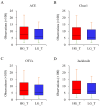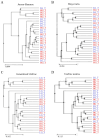Different Prostatic Tissue Microbiomes between High- and Low-Grade Prostate Cancer Pathogenesis
- PMID: 39201629
- PMCID: PMC11354394
- DOI: 10.3390/ijms25168943
Different Prostatic Tissue Microbiomes between High- and Low-Grade Prostate Cancer Pathogenesis
Abstract
Numerous human pathologies, such as neoplasia, are related to particular bacteria and changes in microbiome constituents. To investigate the association between an imbalance of bacteria and prostate carcinoma, the microbiome and gene functionality from tissues of patients with high-grade prostate tumor (HGT) and low-grade prostate tumor (LGT) were compared utilizing next-generation sequencing (NGS) technology. The results showed abnormalities in the bacterial profiles between the HGT and LGT specimens, indicating alterations in the make-up of bacterial populations and gene functionalities. The HGT specimens showed higher frequencies of Cutibacterium, Pelomonas, and Corynebacterium genera than the LGT specimens. Cell proliferation and cytokine assays also showed a significant proliferation of prostate cancer cells and elevated cytokine levels in the cells treated with Cutibacterium, respectively, supporting earlier findings. In summary, the HGT and LGT specimens showed differences in bacterial populations, suggesting that different bacterial populations might characterize high-grade and low-grade prostate malignancies.
Keywords: Cutibacterium; biomarker; high-grade prostate tumor (HGT); low-grade prostate tumor (LGT); prostate cancer; therapeutic targets.
Conflict of interest statement
The authors have no conflicts of interest relevant to this study to disclose.
Figures









Similar articles
-
Prostate and urinary microbiomes in prostate cancer development: focus on Cutibacterium acnes.Front Cell Infect Microbiol. 2025 May 21;15:1562729. doi: 10.3389/fcimb.2025.1562729. eCollection 2025. Front Cell Infect Microbiol. 2025. PMID: 40470262 Free PMC article. Review.
-
Bacterial signatures and their inflammatory potentials associated with prostate cancer.APMIS. 2020 Feb;128(2):80-91. doi: 10.1111/apm.13021. Epub 2020 Jan 28. APMIS. 2020. PMID: 31990107 Review.
-
The Microbiome of the Prostate Tumor Microenvironment.Eur Urol. 2017 Oct;72(4):625-631. doi: 10.1016/j.eururo.2017.03.029. Epub 2017 Apr 20. Eur Urol. 2017. PMID: 28434677
-
The gut microbiota associated with high-Gleason prostate cancer.Cancer Sci. 2021 Aug;112(8):3125-3135. doi: 10.1111/cas.14998. Epub 2021 Jul 5. Cancer Sci. 2021. PMID: 34051009 Free PMC article.
-
Profiling the Urinary Microbiome in Men with Positive versus Negative Biopsies for Prostate Cancer.J Urol. 2018 Jan;199(1):161-171. doi: 10.1016/j.juro.2017.08.001. Epub 2017 Aug 7. J Urol. 2018. PMID: 28797714 Free PMC article.
Cited by
-
Microbiome in urologic neoplasms: focusing on tumor immunity.Front Immunol. 2024 Dec 5;15:1507355. doi: 10.3389/fimmu.2024.1507355. eCollection 2024. Front Immunol. 2024. PMID: 39703512 Free PMC article. Review.
-
Prostate and urinary microbiomes in prostate cancer development: focus on Cutibacterium acnes.Front Cell Infect Microbiol. 2025 May 21;15:1562729. doi: 10.3389/fcimb.2025.1562729. eCollection 2025. Front Cell Infect Microbiol. 2025. PMID: 40470262 Free PMC article. Review.
References
MeSH terms
Grants and funding
LinkOut - more resources
Full Text Sources
Medical
Molecular Biology Databases

